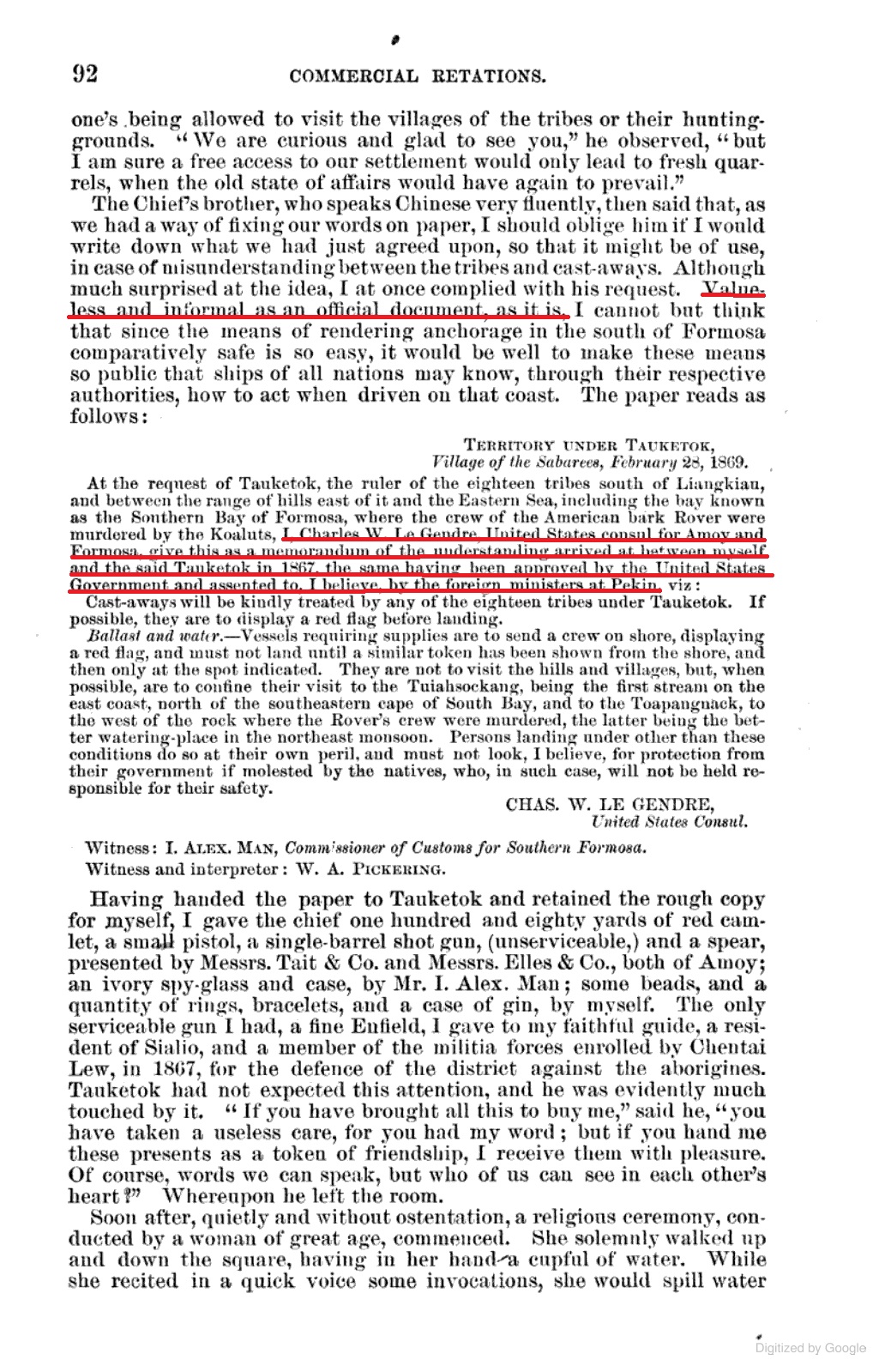

 字體:小 中 大
字體:小 中 大 |
|
|
|
| 2021/08/22 00:28:05瀏覽1666|回應2|推薦4 | |
「南岬之盟」?
電視劇「斯卡羅」正在播映中,劇中人物李仙得的角色是否被過度美化,及其歷史定位也持續在爭議中。官方文宣中也強調,這原住民與美國簽訂的「南岬之盟」,是美國與臺灣斯卡羅雙方直接簽訂的「國際條約」,讓台灣被國際看到。
「南岬之盟」(筆者才疏學淺,不知何人創造這一名詞)是1869年2月美國駐廈門領事李仙得 (Charles W. le Gendre) 與屏東原住民簽訂的「了解備忘錄」。根據Paul D. Barclay 的著作〈Outcasts of Empire: Japans Rule on Taiwans "Savage Border," 1874-1945〉此份「了解備忘錄」並未獲得李仙得在北京的上級認可是一「條約」。不管Paul D. Barclay怎麼說,我們就看看美國官方文獻中是如何記載這段歷史的,美國官方1871年出版的文書中李仙得本人是這麼說的(見所附照片)。
這份「了解備忘錄」要作為一份正式文件,是毫無價值和非正式的。(Valueless and informal as an official document, as it is,)他也寫道 「我,廈門和福爾摩沙的美國領事 Charles W. Le Gendre 將此份我與卓杞篤(Tauketok)於 1867 年達成的協議作成一份了解備忘錄,同樣的文件已獲得美國政府的批准,我相信 也獲得在北京的外交使節團的同意。」(I, Charles W. Le Gendre, United States consul for Amoy and Formosa give this as a memorandum of the understanding arrived at between myself and the said Tauketok in 1867, the same having been approved by the United States Government and assented to, I believe by the foreign ministers at Pekin)
這份「了解備忘錄」是李仙得與卓杞篤在第二次會面時,應卓杞篤的要求,李仙得寫給卓杞篤的。那他們第一次會面時又都談了些什麼?讓我們看看美國官方文獻是如何記載李仙得及卓杞篤的第一次會面吧!以下文字是陳政三先生(文化部文化資產局專門委員)翻譯李仙得1867年11月7日呈給美國公使的報告中的節錄,全文可在原住民委員會網站看到,(括號內文字係翻譯作者陳政三先生的考據、加註): https://ihc.cip.gov.tw/EJournal/EJournalCat/141
隔天早上,我要必麒麟往見卓杞篤,說明爽約理由。必麒麟〔與臺防理番同知(sub-prefect)王文棨同行,〕在保力碰到帶著600名戰士的卓杞篤〔,雙方初步談到和約條件,小必說他與老卓一見如故,還歃血為盟,結拜成兄弟〕。【註30】當天2位將軍的答覆仍未下來,再過一天,卓杞篤無法在保力找到適當紮營處,或是他懷疑官方將不利於他們,或不想再空等,遂打道回社。此時劉總兵發現老卓不見了,深覺不妙,宣稱正要發公函回覆我的條件,央求再讓他安排我與酋長的另次會晤。我同意了。3天後,接獲卓杞篤將在出火山(volcano, 恆春鎮山腳里出火)會晤的通知,該地位於距東海岸4哩處,就在「生番」的領土正中心。我們於10月10日一早出發,只有寶內、必麒麟、〔吳世忠等〕3名通事,以及一位嚮導〔綿仔(Mia)〕隨行,沒帶衛士,中午抵達。【註31】卓杞篤由一群頭目及約200名男女土著環圍,雙方就在眾人中間席地而坐,沒舉行任何儀式。我方未攜帶武器,對方把槍枝擺在雙膝之間。大家都知道上次我沒會見他們的理由,因此無須解釋,我單刀直入問道為何殺害我同胞?卓杞篤急忙回答:「很久以前,白人幾乎將龜仔甪社殘殺殆盡,僅剩3人,以致世世挾怨報仇。由於沒有船可追捕白人,他們只好對上岸的人進行報復。」【註32】我提到這麼做將殃及無辜。「我瞭解,」他說,「我也反對這種行為,所以上次想在保力與你會晤,當面致歉。」我再問未來將如何處理類似案件?他答曰:「假如你們想用武力解決,我們必然應戰,後果如何當然就無法保證了;反之,如希望和平解決,則可確保永世太平。」我說我是以朋友身分出席的,此話一出,他馬上把槍擺在一旁。
我又說我們並非銜恨記仇之人,只要往後船難漂民不再被殺,由他保證加以照顧,並轉交給琅嶠漢人的話,一切好商量。他答應了。我進而表示,萬一船員上岸取水或因事登岸,不應受到侵犯、騷擾。這點他也同意。接著我們約定以他認為最佳的紅旗作信號,意圖派員登岸的船隻應該揮動代表友好的旗幟,事先通知他或他的部落。我們把這項列入當天的〔口頭〕和約中。
李仙得的原文如下: The next morning I requested Mr. Pickering to see Tooke-tok and explain to him why I could not come. He found him in Poliac, attended by 600 warriors. Yet the desired answer from the generals had not been received, and, the day advancing, Tooke-tok, unable to find proper quarters at Poliac, or perhaps suspecting treachery on the part of the Chinese, or else tired of waiting, concluded to leave. General Lew, who by that time had come to the conclusion to answer my note, was visibly troubled at the disappearance of Tooke-tok, and begged of me to let him arrange another interview with the chief. I consented, and three days afterwards was informed that Tooke-tok would meet us at the Volcano, some four miles from the east coast of the island, i. e., in the midst of savage territory. We left on the morning of the 10th of October, without other escort than Mr. Bernare, Mr. Pickering, three interpreters, and one guide, and reached our destination at noon. I found Tooke-tok surrounded by a number of chiefs, and some 200 savages of both sexes. We sat on the ground without ceremony, in the center of the group. We were unarmed—they had their guns between their knees. All knew what had prevented me from meeting them before, so without preamble I began by asking what could have led them to murder our countrymen. Tooke-tok hastened to reply that, a long time ago, white people had all but exterminated the Koolut tribe, leaving only three who survived to hand down to their posterity the desire for revenge. Having no ships to pursue foreigners, they had taken their revenge as best they could. I observed that in this way many innocent victims must have been killed. “I know it,” said he, “and am an enemy to the practice, and therefore sought to join you at Poliac to express my regrets.” I then asked him what he intended doing in the future. His answer was, “if you come to make war, we shall resist you, of course, and I cannot answer for the consequences; if, on the contrary, you desire peace, it shall be so forever.” I told him I had come as a friend, and on hearing it he put his gun aside.
I added that we were not unwilling to forget the past, but that in the future, far from murdering the unfortunate castaways, he should promise to care for them and hand them over to the Chinese of Liang-kiau. He promised to do so. I added that in case a crew was sent ashore for water, or anything else, they should not be molested. This point he agreed to, and we settled upon a red flag (at the chief’s request) as a sign through which ships would make known to him or his tribes a desire to land a party for friendly purposes, under the contract we had entered into that day. 原文網址聯結如下: https://history.state.gov/historicaldocuments/frus1868p1/d268
近年來在台灣一份文件各自解讀的現象充斥,這份「了解備忘錄」是否是美國與臺灣斯卡羅雙方直接簽訂的「國際條約」也就由各位自行解讀了。筆者貼出美方的原始文件,供有興趣者參考,只可惜的是原住民因無文字,沒有原住民本身觀點的記載,現有記載皆為單方面意見。 |
|
| ( 時事評論|社會萬象 ) |










